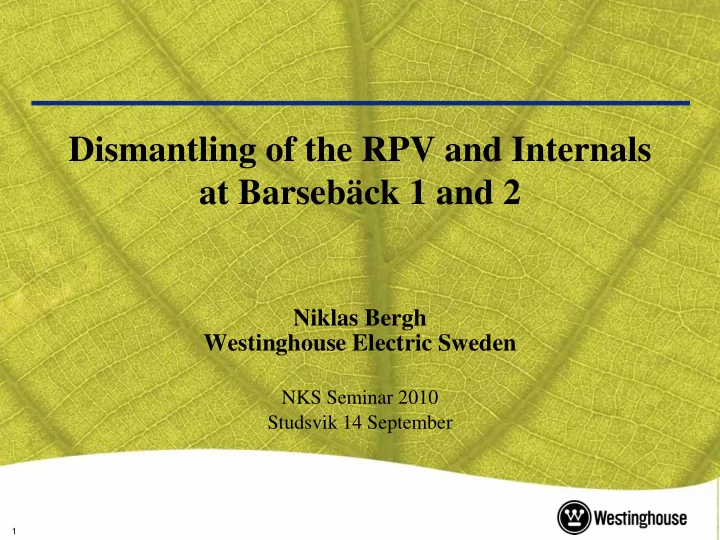

Dismantling of the RPV and Internals at Barsebäck 1 and 2 Niklas Bergh Westinghouse Electric Sweden NKS Seminar 2010 Studsvik 14 September 1
Agenda Introduction Background Segmentation Waste management Time schedule Staffing Conclusions 2
Introduction Barsebäck 1 and 2 (B1 & B2) ASEA-Atom BWR:s Electrical effect 620 MW B1 closed 1999 B2 closed 2005 Waste Introduction Background Segmentation Time schedule Staffing Conclusions management 3
Background Basis for strategic decision: Handling of RPV and Internals • One-piece removal • Segmentation Determine volumes for the expansion of SFR Define year for placement of segmentation contract Waste Introduction Background Segmentation Time schedule Staffing Conclusions management 4
Segmentation methods Thermal techniques • Plasma Arc Cutting • Oxy-fuel Cutting • MDM Mechanical techniques • Shearing • Band sawing • Circular sawing Other • Abrasive Water Jet Cutting Waste Introduction Background Segmentation Time schedule Staffing Conclusions management 5
Segmentation methods – pros and cons Thermal techniques • Fast • Costly • Radiation and visibility issues Mechanical techniques • Minor secondary waste • Easy to install • Reliable • Limited cutting thicknesses Waste Introduction Background Segmentation Time schedule Staffing Conclusions management 6
Internals segmentation Mechanical cutting program recommended due to extensive Westinghouse experiences Wet segmentation in internal parts pool using band saw, shear, tube cutter and circular saw Waste packed in the pool Done in parallel for B1 and B2 Waste Introduction Background Segmentation Time schedule Staffing Conclusions management 7
RPV segmentation Head 1,4 m 1 A combination of dry thermal and 2,0 m 2 wet mechanical cutting 1,8 m 3 Bottom modified for filling/draining 2,0 m 4 Auxiliary support systems installed 2,0 m 5 PAC used to cut annular pieces from the RPV 2,0 m 6 Height of annular pieces < 2 m, 1,6 m 7 avoiding nozzles 2,0 m 8 Bottom Waste Introduction Background Segmentation Time schedule Staffing Conclusions management 8
RPV segmentation Holes made with MDM/drill for lifting of the rings Annular pieces moved to internal parts pool Further segmented with band saw and packed into containers Done in series for B1 and B2 to utilise lessons learned Waste Introduction Background Segmentation Time schedule Staffing Conclusions management 9
Packing Goal: Achieve optimal packing of containers to reduce costs Previous Westinghouse experience: • Internals • 0.4-1.1 ton/m 3 • RPV • 1.0 ton/m 3 Waste Introduction Background Segmentation Time schedule Staffing Conclusions management 10
Activity contents Long-lived to SFL: • Core grid • Core shroud • Core shroud cover • Core spray • Part of control rod guide tubes The rest to SFR Waste Introduction Background Segmentation Time schedule Staffing Conclusions management 11
Containers BFA-tank • 1.3 x 2.3 x 3.3 m • For long-lived LILW Large Steel Box • 1.2 x 2.4 x 2.4 m • For short-lived ILW ISO Container • 6.1 x 2.4 x 1.3 m • For short-lived LLW Waste Introduction Background Segmentation Time schedule Staffing Conclusions management 12
Time schedule Prerequisites: 3 shifts 24 hours per day Internals segmentation done in parallel for B1 and B2 RPV segmentation done in series for B1 and B2 Design & manufacturing phase 2 years Segmentation campaign 2.5 years Waste Introduction Background Segmentation Time schedule Staffing Conclusions management 13
Staffing Manpower on site during the different phases: • Crew of 11 during the internals segmentation • Crew of 14 during the RPV segmentation Functions: • Project management • Engineers (Installation, quality and technical lead) • Operators (Tools and crane) • Decontamination • Health physics • Supervision Waste Introduction Background Segmentation Time schedule Staffing Conclusions management 14
Conclusions Proven technology available for segmentation of RPV and Internals The contract for segmentation should be placed no later than 2017 in order to start establishment on site 2020 Total waste amounts: • 220 m 3 in SFL • 1 360 m 3 in SFR Waste Introduction Background Segmentation Time schedule Staffing Conclusions management 15
Recommend
More recommend